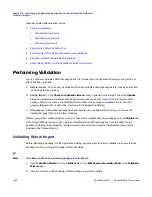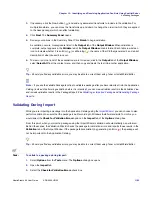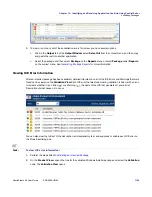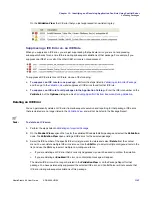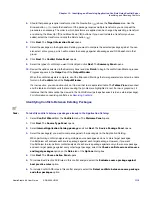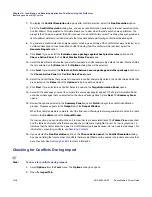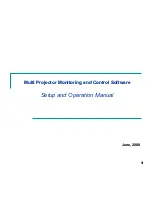
Chapter 13: Identifying and Resolving Application Conflicts Using ConflictSolver
Validating Packages
AdminStudio 9.5 User Guide
ADS-0950-UG00
1101
Note •
Regarding scanning for dependencies, note the following:
•
If the
Only Display View Nodes With Data
option on the General tab of the ConflictSolver and Application
Manager
Options
dialog box
is selected, if you scan for dependencies and no dependencies are found, the
Dependencies
node will still not be displayed.
•
Dependency information is also generated by the Patch Impact Analysis Wizard.
•
If you want to perform validation, scan for dependencies, or conflict resolution on a package that is stored in the
Software Repository, you must check out the package before you begin (because these actions may result in
data in the package being changed).
Validating Packages
An important first step in conflict identification and resolution is to validate the original Windows Installer package.
Validation compares the package against Microsoft ICEs (Internal Consistency Evaluators), custom actions written
by Microsoft which can be executed to determine if an installation package is built according to Windows Installer
standards. ICE rules return the following types of messages:
•
Errors
—Database authoring that causes incorrect behavior. An example of an error would be duplicate
component GUIDs, which would cause the Installer to incorrectly register components.
•
Warnings
—Database authoring that can cause incorrect behavior. Warnings can also report unexpected
side-effects of database authoring. An example of a warning would be entering the same property name in two
conditions that differ only by the case of letters in the name. Because the Installer is case-sensitive, the
Installer treats these as different properties.
•
Informational
—Information from the ICE that do not indicate a problem with the database. Often they are
information about the ICE itself, such as a brief description. They can also provide progress information as the
ICE runs.
Note •
For a full listing and description of all Microsoft ICEs, see
ICE Reference
in the Microsoft MSDN Library.
Ideally, all packages that you import into ConflictSolver will pass validation, but realistically that will not be the case.
ConflictSolver allows you to import any Windows Installer package into ConflictSolver, regardless of whether it has
passed validation or not. However, should you import a Windows Installer package that does not pass validation,
potential issues may arise due to the package not having been authored to Microsoft standards.
You can choose to validate an MSI package either before import, during import, or after import. If you choose to
validate the package after it has been imported into the Application Catalog, those validation results are persisted,
are listed on the
Validation
view, and are included in the Package Report (see
Generating Package Reports
).
Summary of Contents for ADMINSTUDIO 9.5
Page 1: ...AdminStudio 9 5 User Guide Version 9 5...
Page 50: ...Contents 50 ADS 0950 UG00 AdminStudio 9 5 User Guide...
Page 52: ...52 ADS 0950 UG00 AdminStudio 9 5 User Guide...
Page 156: ...156 ADS 0950 UG00 AdminStudio 9 5 User Guide...
Page 440: ...440 ADS 0950 UG00 AdminStudio 9 5 User Guide...
Page 1090: ...1090 ADS 0950 UG00 AdminStudio 9 5 User Guide...
Page 1426: ...1426 ADS 0950 UG00 AdminStudio 9 5 User Guide...
Page 1686: ...1686 ADS 0950 UG00 AdminStudio 9 5 User Guide...
Page 1794: ...Chapter 24 AdminStudio Public API Reference 1794 ADS 0950 UG00 AdminStudio 9 5 User Guide...
Page 1842: ...Index 1842 ADS 0950 UG00 AdminStudio 9 5 User Guide...
















